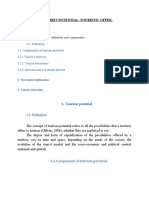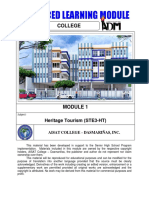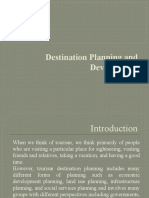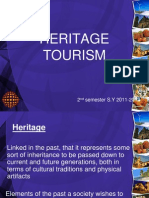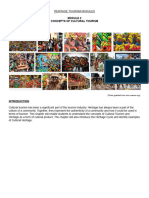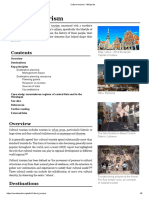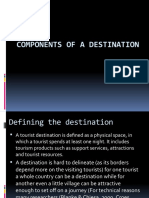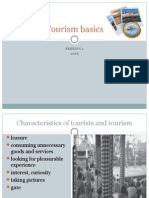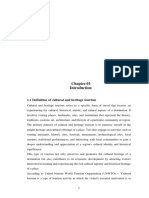Name: Puji Ana Astutik NIM: 932204118 Class: C: Types of Tourism by Destination
Name: Puji Ana Astutik NIM: 932204118 Class: C: Types of Tourism by Destination
Uploaded by
Puji AAnnaCopyright:
Available Formats
Name: Puji Ana Astutik NIM: 932204118 Class: C: Types of Tourism by Destination
Name: Puji Ana Astutik NIM: 932204118 Class: C: Types of Tourism by Destination
Uploaded by
Puji AAnnaOriginal Title
Copyright
Available Formats
Share this document
Did you find this document useful?
Is this content inappropriate?
Copyright:
Available Formats
Name: Puji Ana Astutik NIM: 932204118 Class: C: Types of Tourism by Destination
Name: Puji Ana Astutik NIM: 932204118 Class: C: Types of Tourism by Destination
Uploaded by
Puji AAnnaCopyright:
Available Formats
Name : Puji Ana Astutik
NIM : 932204118
Class : C
TOURISM CLASSIFICATION
BASED ON:
PLACE, PURPOSE, AND TOURISM ATTRACTIONS
Types Tour Based on Place
• Place-based tourism is a general term covering several tourism practices, such as cultural
heritage tourism and ecotourism. Most place-based practices can be grouped into one of
three categories: either cultural, natural, or the built environment - people, land, and cities.
In order to present "place" in its fullest sense, communities must consider their cultural,
natural, and built environment.
some things that tourists should survey or prepare before leaving for a tour. For example, a traveler
is looking for information about:
Country of residence and nationality (for migration statistics)
Transportation
Length of stay
Their place of residence (which provides a spread of regional visitors)
How much in total do they spend based on their purpose of visiting the country if the traveler goes
on a trip abroad.
Types of Tourism by Destination
• There are main characteristics of a tourist destination are:
logical geographic units recognized by visitors;
contains visitor attractions;
access or possible provision of access;
internal transport network;
tourism infrastructure and superstructure exists or can be developed;
administratively possible to be planned and managed.
Coastal destinations, exemplified in seaside resorts.
Urban destinations in cities
Rural destinations that range from ordinary rural areas to national parks, wilderness areas,
mountains and lakes.
Types of Tourism Based on Tourist Attractions
1. Natural Attractions
2. Heritage Attractions
Heritage attractions are attractions that are old and have been around for many years.
Attractions in this category have a certain distinguishing component about them: they have been
around for a long time, are ancient, are historic, and are often cultural in nature. These attractions
tend to represent culture and heritage with historical significance to the site area. Among them are
ruins and monuments, temples, forts, castles, battlefields and railroads.
3. Purpose-Made (Man-Made) Attractions
Purposeful attractions are places that are created by humans and purposefully built to
attract visitors and are also created by humans for pleasure, leisure or business. Among them are
dams, National Parks, museums, markets, amusement parks such as Disney World, galleries, burial
sites including Game Reserves and Theme Parks.
4. Events
Events and festivals are big attractions that attract large numbers of visitors. They are varied
in nature and can be anything from food, cultural, sports, music, seminars or educational exhibitions.
You might also like
- Specimen Aural Test4-5Document30 pagesSpecimen Aural Test4-5gemma_muñoz_390% (10)
- Iii. Tourist Potential. Touristic Offer.: 1. Tourism Potential - Definition and ComponentsDocument24 pagesIii. Tourist Potential. Touristic Offer.: 1. Tourism Potential - Definition and ComponentsAndreea Grecu100% (1)
- Tourism - A Conceptual FrameworkDocument39 pagesTourism - A Conceptual FrameworkJM Tro100% (1)
- Tourism ProductDocument11 pagesTourism ProductLavenderogre 24No ratings yet
- 1 - Heritage N Heritage Tourism - 2075.08.27Document19 pages1 - Heritage N Heritage Tourism - 2075.08.27ranabhatkushal190No ratings yet
- Heritage CH 1-4.Document23 pagesHeritage CH 1-4.worknehdilieNo ratings yet
- Summary Heritage TourismDocument12 pagesSummary Heritage Tourismlaura99bonomiNo ratings yet
- Main BodyDocument21 pagesMain BodyPraloy Chowdhury CM VBD Comilla DistrictNo ratings yet
- Schutte IC Chapter4 Visitor ManagementDocument60 pagesSchutte IC Chapter4 Visitor ManagementRizkaNo ratings yet
- Micro Perspective THC 228 2024Document29 pagesMicro Perspective THC 228 2024MYRTLE SHAWN SABIDONo ratings yet
- Q1-Define Tourism and Explain Different Forms and Types of TourismDocument10 pagesQ1-Define Tourism and Explain Different Forms and Types of Tourismrajviryusu13No ratings yet
- Tourism and Travel ClassDocument8 pagesTourism and Travel Classgladysmasese036No ratings yet
- Week1 Elec Ecotourism 24 25Document6 pagesWeek1 Elec Ecotourism 24 25trishajhoy.almarioNo ratings yet
- Destination Awareness: What Is A Tourist Destination?Document7 pagesDestination Awareness: What Is A Tourist Destination?Islam FarhanaNo ratings yet
- Unit 2Document3 pagesUnit 2tabita1303No ratings yet
- Chapter 2.2Document11 pagesChapter 2.2Reign CastillonNo ratings yet
- Rec Module1 Ste3 HTDocument8 pagesRec Module1 Ste3 HTRusselle CalitisNo ratings yet
- Tourism ManagementDocument57 pagesTourism ManagementEmmanuel G. MasanjaNo ratings yet
- Cultural Tourism and Museums: Barry Lord, Vice PresidentDocument12 pagesCultural Tourism and Museums: Barry Lord, Vice PresidentNadira Dwiputri LaseNo ratings yet
- Micro Perspective of Tourism and Hospitality HandoutsDocument6 pagesMicro Perspective of Tourism and Hospitality HandoutsJohnson FernandezNo ratings yet
- Components of TourismDocument8 pagesComponents of TourismChandrappa NatarajaNo ratings yet
- Destination Planning and DevelopmentDocument17 pagesDestination Planning and DevelopmentIslam FarhanaNo ratings yet
- What Is Tourism?Document6 pagesWhat Is Tourism?Islam FarhanaNo ratings yet
- Adventure TourismDocument14 pagesAdventure TourismDave LionelNo ratings yet
- yogvardhan(stmA3) 22bbna329Document7 pagesyogvardhan(stmA3) 22bbna329Prakhar KhandelwalNo ratings yet
- Enc Encoded Pia6 G2tnVE EW - R - 2uHU7JU yQIrFAQQb34iHrHxO4NfQ6WTEq3g0Y5gDocument14 pagesEnc Encoded Pia6 G2tnVE EW - R - 2uHU7JU yQIrFAQQb34iHrHxO4NfQ6WTEq3g0Y5gVarsha YadavNo ratings yet
- Cultural TourismDocument44 pagesCultural TourismmaryadoNo ratings yet
- Lesson 1 Heritage 2011Document14 pagesLesson 1 Heritage 2011Dominique AndrewNo ratings yet
- Prelims TPPADDocument20 pagesPrelims TPPADChrista Felicia AldayNo ratings yet
- Travel & Trousim 1st Sem (1)Document22 pagesTravel & Trousim 1st Sem (1)Dhananjay SharmaNo ratings yet
- Final Types of TourismDocument4 pagesFinal Types of TourismErika Mae CavanNo ratings yet
- Tourism Destination and AttractionsDocument2 pagesTourism Destination and AttractionsAnnie RapanutNo ratings yet
- Module 2-Cultural TourismDocument8 pagesModule 2-Cultural Tourismcarpioshane686No ratings yet
- TMD 3141 Chapter 04 2023Document21 pagesTMD 3141 Chapter 04 2023mukhawaadivhahoemmanuelNo ratings yet
- Risk and Macro ReviewerDocument24 pagesRisk and Macro ReviewerEscarpe, Elaine F. -ABM202No ratings yet
- Cultural Tourism - Wikipedia PDFDocument5 pagesCultural Tourism - Wikipedia PDFphyu trezaNo ratings yet
- EXPLORING TOURISM IN PAKISTAN by Shawal Khan-21 (Sec-A)Document55 pagesEXPLORING TOURISM IN PAKISTAN by Shawal Khan-21 (Sec-A)ar.shawal22No ratings yet
- Class Notes 1Document3 pagesClass Notes 1gyan_singh0% (1)
- Tourism Policy Prelim TopicsDocument3 pagesTourism Policy Prelim TopicsPauline VillamorNo ratings yet
- Tourism Principles: Angeline E. Basco InstructorDocument58 pagesTourism Principles: Angeline E. Basco InstructorMonette de GuzmanNo ratings yet
- Types of TourismDocument4 pagesTypes of TourismSURYANSH MISHRA 9BNo ratings yet
- Da 1 (TH)Document7 pagesDa 1 (TH)LEGEND GAMERSNo ratings yet
- Attractions and EntertainmentDocument3 pagesAttractions and EntertainmentAndrei Justine Pama BugayongNo ratings yet
- Basic Concept in Tourism Planning and deDocument27 pagesBasic Concept in Tourism Planning and deGlenda AlzonaNo ratings yet
- Week 1-2 Module GTCGEO02Document12 pagesWeek 1-2 Module GTCGEO02Ailene Nace GapoyNo ratings yet
- Igcse Travel and Tourism F3: High Achievers Coach International AcademyDocument6 pagesIgcse Travel and Tourism F3: High Achievers Coach International AcademyTsitsi BunguNo ratings yet
- Group 3 HeritageDocument5 pagesGroup 3 Heritagemicaelaqt1919No ratings yet
- TOURISM GEOGRAPPHYDocument19 pagesTOURISM GEOGRAPPHYsaksham.0211111No ratings yet
- PRINCIPLES OF TOURISM The Meaning and ImDocument6 pagesPRINCIPLES OF TOURISM The Meaning and ImLouise GarciaNo ratings yet
- TH 1 and 2Document7 pagesTH 1 and 2shizea tokioNo ratings yet
- Destination AmlygamDocument40 pagesDestination AmlygamPrecious Tinashe NyakabauNo ratings yet
- CH 3 Tourism DestinationDocument27 pagesCH 3 Tourism DestinationVany OctaNo ratings yet
- File IiiDocument12 pagesFile Iii19. Wahyuni Dianita UtamiNo ratings yet
- BTM6th 1st Unit PDFDocument5 pagesBTM6th 1st Unit PDFMonokuroNo ratings yet
- Tourism BasicsDocument35 pagesTourism BasicsmaryadoNo ratings yet
- Tourism and Travel Management 1111-1Document51 pagesTourism and Travel Management 1111-1shalini sankaran0% (1)
- UNEP Ecotourism 6 BP8-5Document14 pagesUNEP Ecotourism 6 BP8-5emilNo ratings yet
- Cultural and Heritage Tourism in IndiaDocument76 pagesCultural and Heritage Tourism in Indiab43022889No ratings yet
- CHAPTER 1: Definition of Tourism ProductDocument19 pagesCHAPTER 1: Definition of Tourism ProductReoco ManilaNo ratings yet
- TPAD AssignmentDocument4 pagesTPAD Assignmentreyes marcoNo ratings yet
- Reviwer: Puji Ana Astutik NIM:932204118: Backward Design. University of Sydney, Australia RELC, SingaporeDocument1 pageReviwer: Puji Ana Astutik NIM:932204118: Backward Design. University of Sydney, Australia RELC, SingaporePuji AAnnaNo ratings yet
- Tour Packages 4Document1 pageTour Packages 4Puji AAnnaNo ratings yet
- Classification of Packages TourDocument1 pageClassification of Packages TourPuji AAnnaNo ratings yet
- Resume Tour LeaderDocument1 pageResume Tour LeaderPuji AAnnaNo ratings yet
- EQ2 TitlesDocument4 pagesEQ2 Titlesapi-3711998No ratings yet
- BABIESDocument12 pagesBABIESVronik Mtz Kno100% (1)
- Steps in Connecting Your Software To BiometricsDocument42 pagesSteps in Connecting Your Software To BiometricsedenNo ratings yet
- 4-Koma A4 Paper To A5 Size MangaDocument1 page4-Koma A4 Paper To A5 Size MangaJair HernándezNo ratings yet
- DIY Squid HatDocument22 pagesDIY Squid Hatkailani_ishitaNo ratings yet
- Adventures: in The Forgotten RealmsDocument16 pagesAdventures: in The Forgotten RealmsFabiano RodriguesNo ratings yet
- Fifa-15-Manuals Sony Playstation 4 UkDocument22 pagesFifa-15-Manuals Sony Playstation 4 UkJose GomesNo ratings yet
- AIMP3 MemoryManager EventLogDocument135 pagesAIMP3 MemoryManager EventLogsyahrulNo ratings yet
- Understanding QuadratureDocument6 pagesUnderstanding Quadraturekunduru_reddy_3No ratings yet
- 2020 Golf NewsletterDocument17 pages2020 Golf NewsletterBrendan CodyNo ratings yet
- Blindness and Sight in Oedipus RexDocument3 pagesBlindness and Sight in Oedipus Rexitsisha2412No ratings yet
- GiaoandethitienganhDocument5 pagesGiaoandethitienganhCát Tường Nguyễn ThịNo ratings yet
- Target Market AnalysisDocument6 pagesTarget Market AnalysisAllyssa LaquindanumNo ratings yet
- Baby Bath Steps and RationaleDocument3 pagesBaby Bath Steps and RationaleMary Shane MoraldeNo ratings yet
- Shadowfighter (Short Film Script)Document9 pagesShadowfighter (Short Film Script)Sean WuNo ratings yet
- 2023 LC Technology Folio Template and AdviceDocument16 pages2023 LC Technology Folio Template and AdviceDarraghNo ratings yet
- BioAire B520 Instruction ManualDocument6 pagesBioAire B520 Instruction ManualIT TechNo ratings yet
- Badminton Lesson PlanDocument4 pagesBadminton Lesson PlanSulayao Lito NavarroNo ratings yet
- Witcher CheatDocument5 pagesWitcher CheatMark LuNo ratings yet
- Comparative Superlative TestDocument2 pagesComparative Superlative TestEvi BaliNo ratings yet
- MunityDocument98 pagesMunityKonstantin Rall100% (1)
- Ôn Tập Thì Quá Khứ Đơn Và Quá Khứ Tiếp DiễnDocument2 pagesÔn Tập Thì Quá Khứ Đơn Và Quá Khứ Tiếp Diễnthaithanh.tdhtNo ratings yet
- Nammiaca 000050Document982 pagesNammiaca 000050gangadhark196No ratings yet
- Germicidal Action of MilkDocument9 pagesGermicidal Action of MilkMohammad Ashraf PaulNo ratings yet
- Describe Your MomDocument3 pagesDescribe Your MomROXANA UNGUREANUNo ratings yet
- The Best Muscle Building Workout For Natural Bodybuilders v2 PDFDocument1 pageThe Best Muscle Building Workout For Natural Bodybuilders v2 PDFkaran kayasthaNo ratings yet
- Eighteenth Century Painting (Art Ebook)Document214 pagesEighteenth Century Painting (Art Ebook)Josip Bradarić100% (5)
- INFO - by Doctor+ ProductionsDocument6 pagesINFO - by Doctor+ ProductionsSocol IrinaNo ratings yet
- High Low Probability GameDocument4 pagesHigh Low Probability Gameapi-488084761100% (1)

